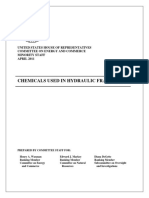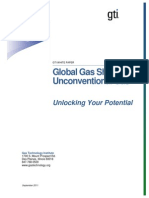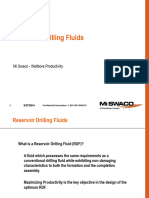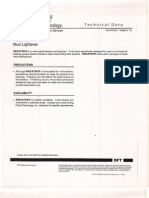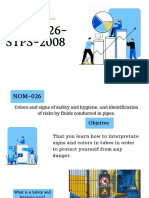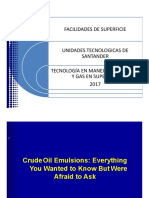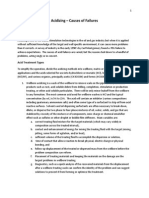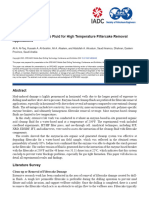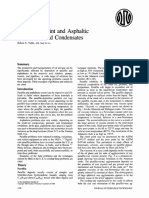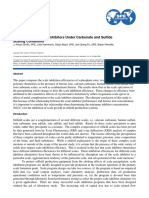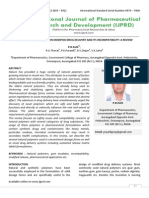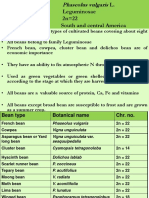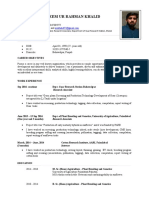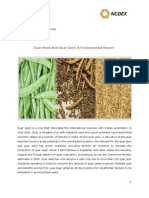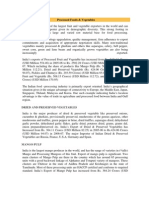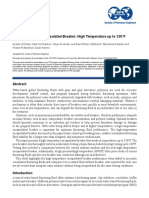Hydraulic Fracturing in HPHT Wells
Hydraulic Fracturing in HPHT Wells
Uploaded by
arispriyatmonoCopyright:
Available Formats
Hydraulic Fracturing in HPHT Wells
Hydraulic Fracturing in HPHT Wells
Uploaded by
arispriyatmonoOriginal Title
Copyright
Available Formats
Share this document
Did you find this document useful?
Is this content inappropriate?
Copyright:
Available Formats
Hydraulic Fracturing in HPHT Wells
Hydraulic Fracturing in HPHT Wells
Uploaded by
arispriyatmonoCopyright:
Available Formats
Hydraulic Fracturing in HPHT Wells
1. Introduction
Hydraulic fracturing fluids are used to initiate and propagate fractures, as well as
transport proppant into fractures in oil bearing formations to increase permeability
and enhance oil production. Proppants are sand grains or other granular substances
that are injected into the formation to hold or “prop” open formation fractures that
have been created by hydraulic fracturing. Proppants wedged within the fracture serve
to increase the permeability of the formation, which promotes oil and gas production.
The fracturing Fluids injected into the formation during hydraulic fracturing are
subsequently pumped back out of the well in the process of extracting the oil and gas
and associated ground water. Some fracturing fluid may remain in the formation due
to “leakoff” or due to the fluids being stranded in the formation.
The types and use of fracturing fluids have evolved greatly over the past 60 years.
Their composition varies significantly, from simple water and sand, to complex
polymeric substances with a multitude of additives. Service companies have
developed a number of different oil and water-based fluids and treatments to more
efficiently induce and maintain permeable and productive fractures. Water-based
fracturing fluids have become the predominant type of coalbed methane fracturing
fluids. In some cases, nitrogen or carbon dioxide gas is combined with the fracturing
fluids to form foam as the base fluid. Foams perform comparably to liquids, but
require substantially lower volumes to transport an equivalent amount of proppant. A
variety of other fluid additives (in addition to the proppants) may be included in the
fracturing fluid mixture to perform essential tasks such as formation clean-up, foam
stabilization, leakoff inhibition or surface tension reduction.
Based on the availability of the scientific literature, it is evident that hydraulic
fracturing fluid performance became a prevalent research topic in the late 1980’s and
Indian School of Mines Dhanbad Page 1
Hydraulic Fracturing in HPHT Wells
the 1990’s. Most of the literature pertaining to these fracturing fluids relates to the
fluids’ operational efficiency rather than the potential ramifications of their use
relative to environmental or human health concerns. There is very little documented
research on the environmental impacts that result from the injection and migration of
these fluids into subsurface formations, soils and underground sources of drinking
water. Some of the existing research does offer information regarding the basic
chemical components present in most of these fluids.
Fig 1: A pictorial representation of fracturing of Marcellus Shale using
conventional water-sand mixture.
Indian School of Mines Dhanbad Page 2
Hydraulic Fracturing in HPHT Wells
2. Literature Survey and Current Status
2.1 Chemical Composition
The main goal of hydraulic fracturing is to achieve a highly conductive fracture.
Fracturing fluids are formulated to provide sufficient viscosity to transport and place
proppant into a fracture, and should degrade or “break” into a low viscosity fluid to
allow for rapid flow-back and clean up. Breaking of the high viscosity fluid can be
facilitated using pre-mixed additives within the fracturing fluid or by injecting breaker
fluids into the well after the fracturing process is complete. Specifically, the following
four qualities are desirable:
Fluid must be viscous enough to create a fracture of adequate width
Fluid must possess characteristics that maximize fluid travel distance to extend
fracture length
Fluid must be able to transport large amounts of proppant into the fracture
Fluid must require minimal gelling agent to allow for easier breaking and
reduced cost.
Some of the fluids and fluid additives commonly used to create fractures are:
linear gels
cross-linked gels
foamed gels
plain water & potassium chloride (KCl)-water
acids
combination treatments (any combination of 2 or more of the aforementioned
fluids).
Indian School of Mines Dhanbad Page 3
Hydraulic Fracturing in HPHT Wells
Fracturing fluids require additives to function efficiently, to maintain stability
and to allow for easy recovery of the fluid for clean-up. These additives
include biocides fluid loss agents, enzyme breakers, acid breakers, oxidizing
breakers, friction reducers, and surfactants, such as emulsifiers and non-
emulsifiers. Several products may exist within each of these categories.
Table.1: Summary of Hydraulic Fracturing Fluid Additives
Product Chemical Composition of
Existing Products
Chemical Compound
Linear gel delivery guar gum derivative
system diesel
Water gelling agent guar gum
water
fumaric acid
Linear gel polymer fumaric acid
adipic acid
Indian School of Mines Dhanbad Page 4
Hydraulic Fracturing in HPHT Wells
Gelling agents Benzene
ethylbenzene
methyl tert-butyl ether
napthalene
polynuclear aromatic
hydrocarbons (PAHs)
polycyclic organic matter
(POM)
sodium hydroxide
toluene
xylene
Crosslinker boric acid
ethylene glycol
monoethanolamine
Crosslinker sodium tetraborate decahydrate
Crosslinkers ammonium chloride
potassium hydroxide
zirconium nitrate
zirconium sulfate
Indian School of Mines Dhanbad Page 5
Hydraulic Fracturing in HPHT Wells
Foaming agent Isopropanol
salt of alkyl amines
diethanolamine
Foaming agent Ethanol
2-butoxyethanol
ester salt
polyglycol ether
water
Foamers glycol ethers
Acid treatment - hydrochloric acid
hydrochloric acid
Acid treatment - formic formic acid
acid
Breaker Fluid diammonium peroxidisulphate
Breaker Fluids (BLM ammonium persulfate
Lists) ammonium sulphate
copper compounds
ethylene glycol
glycol ethers
Indian School of Mines Dhanbad Page 6
Hydraulic Fracturing in HPHT Wells
Microbicide 2-bromo-2nitro1,3-propanediol
Biocide 2,2-dibromo-3-
nitrilopropionamide
2-bromo-3-nitrilopropionamide
Bactericides polycyclic organic matter
(POM)
polynuclear aromatic
hydrocarbons (PAHs)
Acid corrosion inhibitor Methanol
propargyl alcohol
Acid corrosion inhibitor pyridinium, 1-(phenylmethyl)-,
ethyl methyl deriv
thiourea
propan-2-ol
poly(oxy-1,2-ethanediyl)-
nonylphenyl-hydroxy
water
Indian School of Mines Dhanbad Page 7
Hydraulic Fracturing in HPHT Wells
2.2 History of Fracturing Fluids
Formation fracturing using fluids has been employed by the oil and gas industry in the
United States since the early 1940’s (Ely, 1985). Early fracturing fluid technology
involved injection of gelled napalm or fuel oil to increase oil and gas well production
efficiency (Ely, 1985). These techniques were short-lived due to poor performance
and the health hazards generally associated with the chemicals that were used early
on. The next step in fracturing fluid evolution involved the use of gelled oils, fatty
acids and caustic soaps (Ely, 1985). Because of the excessively high friction
associated with these liquids, the industry moved toward the use of water without
additives (Ely, 1985). However, water alone is not always adequate for fracturing
certain formations since its low viscosity diminishes its ability to transport proppant.
Higher viscosity fracturing fluids were needed to overcome this problem, so the
industry developed thickened water starch and then guar-based fluids, also known as
linear gels. Guar is a polymeric substance derived from the ground endosperm of the
guar plant (Ely, 1985). Guar gum, on its own, is non-toxic and, in fact, is a food-grade
product that is commonly used to increase the viscosity and elasticity of foods such as
ice cream.
The success of guar-based fluids led to further advances in viscous liquid technology.
Different guar derivatives were developed, the most popular being hydroxypropylguar
(HPG) and carboxymethylhydroxypropylguar (CMHPG).
One major advance in fracturing fluid technology was the development of cross-
linked gels. Cross-linking agents are added to linear gels in order to provide higher
proppant transport performance relative to the linear gels (Ely, 1985; Halliburton Inc.,
Indian School of Mines Dhanbad Page 8
Hydraulic Fracturing in HPHT Wells
Virginia Site Visit, 2001). Since the introduction of cross-linked fluids, improvements
in these fluids have elevated the performance of fracturing treatments.
Another fracturing fluid that quickly gained popularity alongside the use of gelled
fluids was foam fracturing. The most popular foam-fracturing fluids employ nitrogen
or carbon dioxide as their base gas. The incorporation of inert gases with foaming
agents and water diminished the requirement for large volumes of fracturing liquid.
The gas bubbles in the foam fill voids that would otherwise be filled by fracturing
fluid. Service companies reduce the liquid volume as much as 75 percent by using
foams (Ely, 1985; Halliburton Inc., Virginia Site Visit, 2001). Foaming agents can be
used in conjunction with gelled fluids to achieve an extremely effective fracturing
fluid (Halliburton, Inc., Virginia Site Visit, 2001).
Fig 2: A vertical profile section of shale fracturing treatment.
Indian School of Mines Dhanbad Page 9
Hydraulic Fracturing in HPHT Wells
2.3 Rheology of Fracturing Fluids
A fluid described by the two-parameter rheological model of a pseudo plastic fluid, or
a fluid whose viscosity decreases as shear rate increases. Water-base polymer fluids,
especially those made with guar or XC polymer fit the power-law mathematical
equation better than the Bingham plastic or any other two-parameter model. Power-
law fluids can be described mathematically as follows:
Power-law fluid: Fluids are described as Newtonian or non-Newtonian depending on
their response to shearing. The shear stress of a Newtonian fluid (upper left) is
proportional to the shear rate. Some drilling fluids conform to a power-law fluid
model (upper right), requiring less stress with increasing shear rate. Most drilling
muds are non-Newtonian fluids, with viscosity decreasing as shear rate increases.
Indian School of Mines Dhanbad Page 10
Hydraulic Fracturing in HPHT Wells
Cross linked fracturing fluids obey power model and a specific fracturing fluid
formulation is characterized n’ and k’, which signify the flow behavior and
consistency of the fluid. E.g..
Fig 3: Apparent Viscosity at Various pH and Temperatures for Borate-Crosslinked
35 lb/Mgal Guar Gel at a Shear Rate 65/s and Shear History of 5 min at 1400/s.
Indian School of Mines Dhanbad Page 11
Hydraulic Fracturing in HPHT Wells
2.4 Types of Fluids
Water-based Linear fluids Gelled water, Short fractures, Low
HPG,HEC,CMHPG, temperatures.
CMHEC,etc
Cross-linked fluids Cross-linker Long Fractures, High
+HPG,HEC,or temperatures.
CMHEC,etc.
Surfactant based Surfactant+ counter ion Low permeability formations
Micro polymer Micro polymer +linking For low and high permeability
based agent for moderate temperature.
Table 2: Water based fracking fluids
Each of these fluids is unique in nature, and each possesses its own positive and
negative performance traits. Most of these fluids are water-based, however, they can
also be oil, methanol, or water/methanol mixture based as well. Methanol is used in
lieu of, or in conjunction with, water to minimize fracturing fluid leak-off and
enhance fluid recovery. “Methanol is a common winterizing agent in many additives
and has been used in the base fluid of many fracturing treatments…” Polymer-based
fracturing fluids made with methanol usually improve fracturing results, but create a
requirement for 50 to 100 times the amount of breaker (Ely, 1985). Methanol breakers
are typically acids.
Indian School of Mines Dhanbad Page 12
Hydraulic Fracturing in HPHT Wells
Gelled Fluids
Water gellants or thickeners are used to create linear and cross-linked fluids. Gellant
selection is based upon formation characteristics such as pressure, temperature,
permeability, porosity, zone thickness, etc. Both linear and cross-linked fluid fluids
are described in the following sections.
Linear Gels
A substantial number of fracturing treatments are completed using thickened, water
based linear gels. The gelling agents used in these fracturing fluids are typically guar
gum, HPG, CMHPG, carboxymethyl guar, hydroxyethylcellulose (HEC) or other
cellulose derivatives. Guar, cellulose and their derivatives are polymeric substances
used to increase the viscosity of the fracturing fluid. To formulate a gel fluid, guar
powder or concentrate is dissolved into a carrier fluid so it can create the viscous
fracturing liquid. Increased viscosity improves the ability of the fracturing fluid to
transport proppant with less need for turbulence. Concentrations of guar gelling
agents within fracturing fluids have decreased over the past several years. It was
determined that reduced concentrations provide better and more complete breaks in a
fracture (Powell et al., 1999).
Hydraulic fracturing gels are typically made up of a gel thickening agent and a carrier
fluid. Examples of industrially produced gel thickeners include, hydroxypropylguar
blends, guar gum blends, hydroxypropylcellulose, hydroxyethylcellulose, sodium
Indian School of Mines Dhanbad Page 13
Hydraulic Fracturing in HPHT Wells
carboxymethylcellulose and cellulose derivatives. In general, these products are
biodegradable.
Gel thickeners are slurried into a carrier fluid such as water or diesel fuel. Diesel is
frequently used in lieu of water to dissolve the guar powder because its carrying
capacity per unit volume is much higher (Halliburton, Inc., 2002). “Diesel is a
common solvent additive, especially in liquid gel concentrates, used by many service
companies for continuous delivery of gelling agents in fracturing treatments” (GRI,
1996). Diesel does not enhance the efficiency of the fracturing fluid; it is merely a
component of the delivery system (Halliburton, Inc., 2002). Using diesel instead of
water minimizes the number of transport vehicles needed to carry the liquid gel to the
site (Halliburton, Inc., 2002).
Cross-linked Gels
The first cross-linked gels were developed (Ely, 1985) in 1968. When cross-linking
agents are added to linear gels, the result is a complex, high-viscosity fracturing fluid
Messina, Inc. website, 2001). Cross-linking reduces the need for fluid thickener, and
extends the viscous life of the fluid indefinitely. The fracturing fluid remains viscous
until a breaking agent is introduced to break the cross-linker, and eventually the
polymer. Although they make the fluid more expensive, cross-linkers can
considerably improve performance hydraulic fracturing performance, hence
increasing oil well production rates.
Cross-linked gels are typically metal ion-cross-linked guar (Ely, 1985). Service
companies have used metal ions, such as chromium, aluminum, titanium or other
metal ions to achieve cross-linking (Ely, 1985). In 1973, low-residue (cleaner) forms
Indian School of Mines Dhanbad Page 14
Hydraulic Fracturing in HPHT Wells
of crosslinked gels were developed, such as cross-linked hydroxypropylguar (HPG)
(Ely, 1985).
Cross-linkers may contain hazardous constituents, including ammonium chloride,
potassium hydroxide, zirconium nitrate, and zirconium sulfate, boric acid, sodium
tetraborate decahydrate, ethylene glycol and monoethylamine
Indian School of Mines Dhanbad Page 15
Hydraulic Fracturing in HPHT Wells
2.5 Guar Based Fracturing Fluid Chemistry
Polymer-thickened, water-based fluids were first used in the early 1960s, and by the
late 1960s, guar gum had become the polymer of choice because of its lower cost and
highly controllable rheological behavior. The early 1970’s saw significant growth in
guar-based fracturing fluid technology. Controlled cross-linking reactions were
evoked to provide the rheological properties required to provide low fluid loss to the
formation and adequate elasticity to transport proppant into the fracture. While these
fluids were robust and large fractures could be achieved, the economic performance
did not justify the cost. It became generally recognized that cross linked guar polymer
also caused a dramatic loss in fracture conductivity. Laboratory measurements
indicated that often less than 10% of the native fracture conductivity was achieved.
Most of the remaining fracturing-fluid history centers on reducing the conductivity
damage that guar-based polymers cause. Popular polymer-based fracturing fluid-
systems are built on the naturally occurring polysaccharide, guar gum. Guar gum is
isolated from the endosperm of guar beans by a combination of mechanical and
chemical processing steps and generally is supplied as a dry powder. This dry powder
is a complex mixture of materials with the predominant component being a copolymer
of two simple sugars, galactose and mannose. The remainder is typically 10 to 15%
water and 5 to 15% insoluble residue. This insoluble residue is a mixture of protein,
cellulose, and glycolipids and is believed to be a major contributor to the loss of
fracture conductivity.
Indian School of Mines Dhanbad Page 16
Hydraulic Fracturing in HPHT Wells
POLYMER RESIDUE COMPARISON
5
4
3
%
2 % VOL
1 % WT
0
GUAR HPG CMHPG
GUAR AND ITS RESIDUES
Several chemical processes have been developed to refine guar gum to reduce the
amount of permeability damaging in-soluble residue that is present. The most popular
of these processes is reacting guar with propylene oxide to form hydroxypropyl guar
(HPG). This polymer is most often used in high-performance fracturing fluids because
of the low level of insoluble residue and its compatibility with most brine solutions.
The reaction of guar, or HPG, with chloroacetic acid, results in carboxymethyl guar
(CMG) or carboxymethylhydroxypropyl guar (CMHPG). Both of these are anion
polymers, and the additional chemical processing required manufacturing these
derivatives results in products that have lower insoluble residue content.
Guar-based polymers are excellent viscosifiers for water and are used extensively in
the food and cosmetic industries, since they are environmentally favorable because of
their high biodegradability. As fracturing fluids, their ability to viscosify water is
further enhanced by cross linking with several metal or transition metal compounds.
Cross linking leads to highly elastic fluid rheology that provides proppant transport
properties required for fracturing fluids to permit the proper placement of proppant.
Indian School of Mines Dhanbad Page 17
Hydraulic Fracturing in HPHT Wells
One of the first, and most widely used, groups of cross linkers for high pH fluids was
the borates. Initially, borax (sodium tetraborate decahydrate) and boric acid (plus
caustic soda) were used but, in recent years, these have been superseded for many
applications by more exotic boron compounds. Minerals like colemanite and ulexite,
which consist mainly of low solubility calcium or calcium/sodium borate, have been
employed for high temperature applications or when a delayed cross link is required .
Organoborates, formed by completing boron with certain organic ligands, are used for
the same purpose. Irrespective of the form in which boron is added to the fluid, the
cross linking species is the monoborate ion. This interacts, probably by hydrogen
bonding or perhaps by ionic bonding, with the cis-hydroxyls on the guar to provide
either inter- or intra-molecular cross linking, or both.
Prior to the advent of high-temperature borate fluids, fracturing applications at
elevated temperature required the use of alternative cross linkers. Many of these other
cross linking agents are still in use today and include several transition metal species.
By far, the most common amongst these are the titanium (IV) and zirconium (IV)
compounds. The actual materials used tend to be complexes of the relevant metal with
Indian School of Mines Dhanbad Page 18
Hydraulic Fracturing in HPHT Wells
a variety of organic ligands or chelating agents. Typical materials include titanium
acetyacetonate, titanium mono-triethanolamine chelate, zirconium ammonium lactate
and zirconium tetra-acetate. In aqueous solution, and dependent on pH, temperature
and time, these organometallic complexes hydrolyse to yield the actual cross-linking
species. It was thought that these materials cross link polymers by way of covalent
bond formation between single metal atoms and cis-diol pairs on adjacent chains.
Cross Linkers And pH
10
ZIRCONATES
10
ORG.TITANATES
ALUMINATES
6
12
BORATES
0 2 4 6 8 10 12 14
PH
Fig 4: pH range for various cross-linkers
Apart from high-temperature applications, another important use of organ metallic
cross linkers is to provide low-pH fluids. These are particularly useful as pad fluids in
Indian School of Mines Dhanbad Page 19
Hydraulic Fracturing in HPHT Wells
acid fracturing applications as well as in conventional hydraulic fracturing situations
where C02-compatibilty is required. The cross linkers used includes some of the
zirconium and titanium compounds mentioned above. However, Aluminum (III) and
Antimony (V) compounds have been used with certain polymers and for specific
applications.
CROSS LINKERS AND TEMPERATURES
ZIRCONATES 350
200
ALUMINATES
315
TITANATES
350
HTBORATES
250
CON.BORATES
0 50 100 150 200 250 300 350 400
TEMP DEG F
Fig 5: Temperature (0F) ranges for various cross linkers
Drawbacks of Guar Based Fluids:
One major drawback of fracturing fluids prepared with any of these metal cross
linkers their shear-sensitivity ie. exposure of the cross-linked fluid to high shear
causes irreversible damage to its properties, particularly its viscosity and proppant-
carrying characteristics. From a practical standpoint, this has important implications
Indian School of Mines Dhanbad Page 20
Hydraulic Fracturing in HPHT Wells
and is one more reason to delay the crosslinking of these fluids since they are
normally exposed to high shear rates while transiting the well tubular and passing
through the perorations. It is, therefore, important when using these fluids, to test
them under conditions that simulate, as closely as possible, the true shear history and
temperature to which they will be exposed.
Another major drawback of the organometallic cross-linked gel systems is their
relatively poor clean-up characteristics. Independent testing, by industry-recognized
groups , has shown significant proppant pack/formation face damage resulting from
the use of such fluids. With some systems, the proppant pack may exhibit so-called
“regain conductivities” (the ratio of final to initial proppant pack permeability
expressed as a percentage in the range of only 15-60 percent. This loss, of up to 85
percent of the fracture conductivity, is obviously of great significance particularly in
wells capable of high productivity. In such wells, every effort must be made to
maximize the contrast between fracture conductivity and reservoir permeability. An
85 percent loss of conductivity due to damage is clearly unacceptable and can
seriously affect the results of such a treatment. In such cases, use of cleaner fluids
would greatly improve fractured well performance.
Indian School of Mines Dhanbad Page 21
Hydraulic Fracturing in HPHT Wells
2.6 Fluid Additives
Several fluid additives have been developed to enhance the efficiency and increase the
success of fracturing fluid treatments. The major categories of these additives are
defined and briefly described in the following sections.
Foamed Gels
Foam fracturing is a technology that uses foam bubbles to transport and place
proppant into fractures. Foams, which are gas-liquid emulsions, have nitrogen or
carbon dioxide as the fluid’s gaseous component. The use of foams is regarded as one
of the least environmentally damaging fracturing methods because these fluids utilize
fracturing fluid with higher proppant concentrations to achieve highly effective
fracturing. The high concentrations of proppant allow for an approximate 75%
reduction in the overall amount of fluid that would otherwise be necessary using a
conventional linear or cross-linked gel Ely, 1985; Virginia Site Visit, 2001). Foams
can also be cross-linked for enhanced performance results (Ely, 1985; Halliburton,
2001).
Foam fracturing treatments use nitrogen or carbon dioxide as the base gas for the
foam. Foam emulsions experience high leak-off; therefore, typical protocol involves
the addition of fluid loss agents, such as fine sands (Ely, 1985; Halliburton, 2001).
Foaming agents suspend air, nitrogen, or carbon dioxide within the aqueous phase of
a fracturing, acidizing, or gelled acid treatment. The gas/liquid ratio determines if a
fluid will be true foam, or simply gas-energized (Ely, 1985). Carbon dioxide can be
Indian School of Mines Dhanbad Page 22
Hydraulic Fracturing in HPHT Wells
injected as a liquid while nitrogen must be injected as a gas to prevent freezing
(Halliburton, Inc., 2002).
Water & Potassium Chloride Water Treatments
Many service companies use ground water pumped directly from the formation or
treated water to generate adequate fracture length. In some coalbed methane well
stimulations, proppant use is not necessary to prop fractures open, so simple water or
slightly thickened water can be a cost effective substitute for an expensive polymer or
foam based fracturing fluid with proppant (Ely, 1985). Hydraulic fracturing
performance is not exceptional with plain water, but, in some cases, the production
rates achieved are adequate. Plain water has a lower viscosity than gelled water,
which reduces proppant transport capacity.
Breakers
Breaker fluids are used to degrade the fracturing fluid viscosity, which helps to
enhance post-fracturing fluid recovery, or flow back. Natural or propagating fractures
may open and allow fluids to flow through during high fracturing pressure, but may
also subsequently trap the fluids as they close after fracturing pressure decreases (the
“check-valve” effect) (Warpinski et al., 1988; Palmer et al., 1991a). Experiments
performed by Stahl and Clark (1991) confirm that this phenomenon dominates fluid-
loss behavior in coal beds. Contrary to conventional formations where “leak-off” and
fluid invasion may penetrate only a few inches, stimulation fluids in coal penetrate
from 50 to 100 feet away from the fracture and into the surrounding formation
(Palmer et al., 1991; Puri et al., 1991). If a fracturing fluid is injected at very high
pressure a great distance into a formation, and “leaks off” into secondary or existing
Indian School of Mines Dhanbad Page 23
Hydraulic Fracturing in HPHT Wells
fractures, it is possible that it will remain stranded if the flowback and production
processes do not recover it.
It is report that several studies relating to guar-based polymer gels document flow-
back recovery rates of approximately 30-45%. Willberg et al. (1997) report that
polymer recovery rates during flow back averaged 29-41% of the amount pumped
into the fracture. The results from this study were derived from tests performed on 10
wells over periods of four or five days (Willberg et al., 1997). Willberg et al. (1998)
report that polymer returns at conservative flow back rates averaged 25-37% of the
amount pumped into the fracture, while returns at aggressive flow back rates averaged
37-55%. The results from this study were derived from tests performed on 15 wells
over periods of two days at aggressive flow back rates and five days at conservative
flow back rates.
Breakers can be mixed in with the fracturing fluid during pumping, or they can be
introduced later as an independent fluid. There are a variety of breaker types including
time-release and temperature dependent types. Most breakers are typically acids,
oxidizers, or enzymes (Messina, Inc. website, 2001). Breakers may contain hazardous
constituents, including ammonium persulfate, ammonium sulphate, copper
compounds, ethylene glycol, and glycol ethers.
Indian School of Mines Dhanbad Page 24
Hydraulic Fracturing in HPHT Wells
Biocides
One problem that arises when using organic polymers within fracturing fluids is the
incidence of bacterial growth within the fluids. Due to the presence of organic
constituents, the fracturing fluids provide a medium for bacterial growth. As the
bacteria grow, they secrete enzymes that break down the gelling agent, which reduces
the viscosity of the fracturing fluid. Reduced viscosity translates into poor proppant
placement and poor fracturing performance. To alleviate this degradation in
performance, biocides, bactericides, or microbicides are added to the mixing tanks
with the polymeric gelling agents to kill any existing microorganisms, and to inhibit
bacterial growth and deleterious enzyme production. These additives are used to kill
microorganisms such as sulfate reducing bacteria, slime forming bacteria, and algae.
Fluid-Loss Additives
Fluid loss additives restrict leak-off of the fracturing fluid into the exposed rock at the
fracture face. By restricting leak-off, fracturing fluid effectiveness and integrity is
maintained. Fluid loss additives of the past and present include bridging materials
such as 100 mesh sand, 100 mesh soluble resin, and silica flour, or plastering
materials such as starch blends, talc silica flour, and clay (Ely, 1985).
Friction Reducers
To optimize the fracturing process, aqueous fluids must be pumped at maximum rates
and fluids must apply maximum hydrostatic pressure within the treatment process.
Increasing flow velocities and pressures in this manner can lead to undesirable levels
Indian School of Mines Dhanbad Page 25
Hydraulic Fracturing in HPHT Wells
of friction within the infrastructure and the fracture itself. In order to minimize
friction, friction reducers are added to aqueous-based fracturing fluids. These are
typically latex polymers or copolymers of acrylamides. They are added to slick water
treatments (water with solvent) at concentrations of 0.25-2.0 pounds per 1,000 gallons
(Ely, 1985). Some examples of friction reducers include oil soluble anionic liquid,
cationic polyacrilate liquid, and cationic friction reducer (Messina, Inc. website,
2001).
Acid Corrosion Inhibitors
Corrosion inhibitors are required in acid fluid mixtures because acids are corrosive to
steel tubing, well casings, tools, and tanks. Acetone is a solvent that is commonly
used as an additive in corrosion inhibitors). These products can affect the liver,
kidney, heart, central nervous system, and lungs. They are quite hazardous in their
undiluted form. These products are diluted to a concentration of one gallon per 1,000
gallons of make-up water and acid mixture (Halliburton, Inc., Virginia Site Visit,
2001; Schlumberger, Ltd., 2001, Written Correspondence). Acids and acid corrosion
inhibitors are used in very small quantities in coalbed methane fracturing (500 to
2,000 gallons per treatment).
Proppants
The purpose of a proppant is to prop open a hydraulically created fracture. An ideal
proppant should produce maximum conductivity in a fracture. Fracture conductivity is
a function of proppant pack thickness (volume), roundness, purity and crush strength.
Indian School of Mines Dhanbad Page 26
Hydraulic Fracturing in HPHT Wells
In coalbed methane fracturing, the most predominantly used proppant is pure sand of
varying mesh size.
Fig 6: COMARISON OF RETAINED CONDUCTIVITIES OF WATER
BASED FLUIDS
100
90
80
70
60
50 %RET.COND
40
30
20
10
0
GUAR LOW GUAR VES
Indian School of Mines Dhanbad Page 27
Hydraulic Fracturing in HPHT Wells
2.7 Viscoelastic Surfactant (VES) Fracturing Fluids
In 1997, a revolutionary fracturing fluid was introduced to the oilfield. As an
alternative to the conventional polymer/ breaker approach, the newly developed fluid
system uses a viscoelastic surfactant (VES); similar to that is used in shampoos or
liquid detergents, to develop sufficient viscosity to create a fracture and transport
proppant.
The principal advantages of viscoelastic surfactant fluids are ease of preparation, no
formation damage and high-retained conductivity of the proppant pack. The fluid is
prepared by mixing sufficient quantity of VES in brine. Since no polymer hydration is
required, the surfactant concentrate can be metered continuously into the brine. No
crosslinkers, breakers or other chemical additives are necessary.
This product has made fracturing operation simple and reliable. This is not only
because of the fewer number of chemicals required at the location compared to guar
systems, but also due to its simple operation. A comparison of the chemicals required
to prepare VES fluid and those for a typical guar fluid system are listed on the next
page:
VES Treatment Guar Treatment
VES surfactant concentrate Biocides
Stabilizer Clay stabilizer
Polymer
Hydration buffer
Buffer
Indian School of Mines Dhanbad Page 28
Hydraulic Fracturing in HPHT Wells
Surfactant
Caustic
Delay additives
High Temperature stabilizer
Iron control agents
Cross linker
Cross linker stabilizer
Activator
Breakers
Breaker aid
The key to this technology is the use of a viscoelastic surfactant that eliminates the
use of polymers in fracturing operations. There are different types of fluid
formulations available for various temperatures and for different stimulation
techniques. The most commonly used formulation is that using a quaternary
ammonium salt with inorganic salt such as potassium chloride, ammonium chloride or
ammonium nitrate. Changing the brine to an organic salt such as sodium salicylate
can increase the high temperature performance of this fluid.
The properties of the VES fluid are due to its unique chemistry. Viscoelastic
surfactants are very small molecules with a size of the order of 5,000 times smaller
than guar molecules. It consists of a hydrophilic head group and a long hydrophobic
tail. In the presence of brine, they form elongated micellar aggregates. When the
Indian School of Mines Dhanbad Page 29
Hydraulic Fracturing in HPHT Wells
surfactant concentration in the VES fluid is above a certain critical concentration, the
micellar structures entangle and form a mesh like structures. These structures are
responsible for the extraordinary proppant transport characteristics at low viscosities.
Upon contact with oil or gas or dilution by formation water, the VES fluid reduces
viscosity by breaking down the worm-like micelles to a much smaller spherical
micelles. The spherical micelles cannot entangle with each other and hence the
resulting fluid has water-like viscosity, allowing the fracturing fluid to flow back to
the surface along with the produced fluids, leaving a highly conductive proppant pack.
CTAB
Sub Unit M
Thread like micelles
A model for entanglement formation and scission
Fig 7: Micelles formation of Cetyltrimethyl Ammonium Bromide with
Sod. Salicylate.
The viscosity of VES fluids remains constant at a given temperature until contacted
by formation fluids or added chemical breakers. Without polymer, VES fluids leak off
without building a filter cake and the viscosity remains constant, resulting in more
controlled, predictable fracture geometry.
Indian School of Mines Dhanbad Page 30
Hydraulic Fracturing in HPHT Wells
Where low differential stress barriers exist, VES fluid viscosity can be lowered to
keep the fracture from growing out of zone. This is especially critical when fracturing
into a water zone or gas cap.
2.8 Typical Case Histories of VES Fluids:
Two identical offset wells were hydraulically fractured at the Mesa Verde formation
at Rock Springs, Wyoming. Both wells had three zones (Lower Almond, Middle
almond and Lewis) and the bottom hole temperatures of these zones ranged between
176 o F and 190 o F. The permeability of the zones was between 0.03 to 0.05 md with
a frac gradient between 0.72 to 0.95 psi/ft. These treatments were pumped through a 2
7/8 th inch tubing at a rate of 24 to 31 bbls/min. Of these two wells, one was fracture
stimulated with a low guar fluid (25 lb/1000 gallon) and the other with the VES fluid.
The logs from both wells were identical, especially in the pay zones. The first well
that was fracture stimulated using polymer fluid was designed based on standard
practice from past treatments in the area. The fracture stimulation treatment utilized
32% pad and placed 81% of the designed proppant volume into the formation. Since
the well showed signs of screening out during the 4 ppa stage, the 5 ppa stage was
delayed, and the designed 6 ppa stage was eliminated. The well was flowed back
immediately after the frac, a standard practice for the area. Induced Stress Diversion
(ISD) technique, a staged hydraulic fracture treatment methodology without the aid of
a positive zonal isolation via bridge plugs, frac baffles, sand plugs or ball sealers, was
used to separate frac stages.
Indian School of Mines Dhanbad Page 31
Hydraulic Fracturing in HPHT Wells
After the well was flowed for a short period, the middle zone was perforated. Again
for this stage also only 80% of the designed proppant volume was placed. For the first
two stages of these treatments, the maximum proppant concentration that was pumped
did not go beyond 5 ppa (6 ppa was the designed maximum proppant concentration).
This was due to the increase in bottom-hole pressure as the 4 ppa stage entered the
perforations. In both cases the wellbore was flushed completely. When pumping
polymer fluid system on the upper zone, the pad volume was increased to 36% and
the job was redesigned to go up to 5 ppa and to place 217,000 lb proppant.
The offset well with identical three zones was then fracture stimulated with the VES
fluid system. The proppant and fluid volumes used were calculated in order to achieve
fracture lengths comparable to those fractured with the polymer fluid. A calibration
treatment was performed on the Lower Almond zone to determine the fracture closure
pressure, fluid leak-off coefficient, and fluid efficiency.
Indian School of Mines Dhanbad Page 32
Hydraulic Fracturing in HPHT Wells
Brine environment
Oil environment
Surfactant
molecule
Hydrocarbon core
Activator
Surfactant molecules Activator
Fig 8: Breaking VES fluids: No additional chemicals are usually needed to break
VES fluids. Dilution by formation water or contact with hydrocarbons will
disrupt the rod-shaped micelles, breaking the fluid.
The fluid efficiency for the VES fluid in the lower zone was 50% compared to 42%
for the guar fluid system. A 40% pad was used for the lower zone and job was
pumped at a rate of 25 bpm to completion. As designed, up to 6 ppa proppant
concentration was placed. The average treating pressures were 7,000 psi for the VES
fluid compared to 7,850 psi for the polymer fluid. The two upper zones were also
pumped to completion as designed, with a pad volume of 32 and 20% respectively.
Use of such low volumes of pad was due to the improved fluid efficiency noticed on
calibration tests and the initial two fracturing operations using VES.
Indian School of Mines Dhanbad Page 33
Hydraulic Fracturing in HPHT Wells
Post-job pressure history matching on the two wells indicated that the two lower
zones had fairly equivalent calculated hydraulic fracture lengths in both polymer and
VES treatments. The amounts of fluid and proppant used for the job, and the
calculated hydraulic fracture properties based on post-job pressure history matching
are listed
Polymer fluid
VES fluid
Fig 9: The picture shows VES treatment fracture height is contained with the zone
of interest, where conventional polymer based fluid system breakes through the
barrier leading to inefficient proppant placement.
The major difference between the crosslinked polymer system and VES treatments is
the resulting fracture height. For all treatments utilizing guar, the fracture heights
were more than twice when compared to VES fluids. This is due to higher viscosity of
the polymer fluid systems. The polymer fluids resulted in fractures outside of the pay
zones and propping open non-productive zones. With the low viscosity of the VES
fluids, the fracture tends to stay confined in the pay zone. The proppant-pack
conductivity is also maximized due to the non-damaging feature of the VES fluid
Indian School of Mines Dhanbad Page 34
Hydraulic Fracturing in HPHT Wells
system. These unique characteristics of the fluid can result in long effective fractures
compared to those with polymer fluids.
This is conformed by pressure transient studies and also from pressure history match
for the various zones using fracture simulators. The results showed that similar
fracture lengths could be obtained when using VES fluids by using lower volumes of
fluid and proppant. Flowback results showed that the wells that were fracture
stimulated with the VES fluid cleaned-up faster than the offset well fracture
stimulated with the polymer fluid. Initial stabilized production from both wells
showed that the wells treated with the VES fluid had better production; 2.8
MMSCF/D compared to 1.3 MMSCF/D for the offset well stimulated with the low
Guar fluid.
Fig 10: A comparison of job parameters and fracture
simulation for polymer and VES fluids
Lower Almond Middle Almond Lewis Total Average
/Well
VES Guar VES Guar VES Guar VES Guar VES Guar
Prop Vol. (lb) 86k 140k 106k 121k 118k 217k 310k 478k 103 159
Fluid vol.( bbl) 1046 1727 951 1609 877 2084 2877 5420 959 1806
Pad Vol ( bbl) 354 662 427 714 164 723 945 2099 315 700
Conductivity md/ft 511 394 1096 270 908 697 838 453
369 385 438 435 204 385 337 401
Frac length (ft) 97 167 80 203 127 245 101 205
Frac Height (ft)
Cumulative production 222,151 162,568
for six months MMscf/d
(MMscf/D
9100
9150
9200
9250
9300
9350
9400 6000 7600 8000 0 50 100 150 200 250 300 350 400 450 500 0 100 200 300 400 500
Fracture Half-length ft Fracture Half length ft
Indian School of Mines Dhanbad Page 35
Hydraulic Fracturing in HPHT Wells
Since the introduction of the VES fluid, a number of successful fracturing treatments
have been performed and the results from these treatments proved that VES system
offers better opportunity than alternate technologies (polymer systems) to achieve
long term production, while utilizing much lower volumes of fracturing fluid and
proppant system.
Polymer fluid
VES fluid Shale
Zone
of
interest
Shale
Fig 11: A pictorial representation of fracture half lengths obtained when
stimulation treatment is performed using polymer (left and) VES (right) fluids.
Indian School of Mines Dhanbad Page 36
You might also like
- Safety Data Sheet: SECTION 1: Identification of The Substance/mixture and of The Company/ UndertakingDocument14 pagesSafety Data Sheet: SECTION 1: Identification of The Substance/mixture and of The Company/ UndertakingAchraf Ben DhifallahNo ratings yet
- Project Report On GUAR GUMDocument5 pagesProject Report On GUAR GUMrajibmukherjeek100% (1)
- Alkhalaf 2019Document15 pagesAlkhalaf 2019Christian Echeverri ZapataNo ratings yet
- Polymer Systems For Water Shutoff and Profile Modification: A Review Over The Last DecadeDocument15 pagesPolymer Systems For Water Shutoff and Profile Modification: A Review Over The Last DecadeLeopold Roj DomNo ratings yet
- Recovery Methods For Heavy Oil and Bitumen in The 21st CenturyDocument12 pagesRecovery Methods For Heavy Oil and Bitumen in The 21st CenturyarlenNo ratings yet
- KS 2021 WB02 Will Shale Impede or Accelerate The Global Energy Transition - 1Document28 pagesKS 2021 WB02 Will Shale Impede or Accelerate The Global Energy Transition - 1ahmed kabelNo ratings yet
- Euncl PCC 002 PDFDocument19 pagesEuncl PCC 002 PDFAnvesh DonthulaNo ratings yet
- Mechanism of An Asphaltene Inhibitor PDFDocument50 pagesMechanism of An Asphaltene Inhibitor PDFTEXOPED Parsian KishNo ratings yet
- PDFDocument45 pagesPDFDaniel Dennis Escobar SubiranaNo ratings yet
- Polymer Flooding IntroductionDocument293 pagesPolymer Flooding IntroductionoreNo ratings yet
- Hydraulic Fracturing Report 4.18.11Document32 pagesHydraulic Fracturing Report 4.18.11Aayush BhatnagarNo ratings yet
- AADE-05-NTCE-29 Hole Cleaning: The Achilles' Heel of Drilling Performance?Document9 pagesAADE-05-NTCE-29 Hole Cleaning: The Achilles' Heel of Drilling Performance?Waleed Barakat MariaNo ratings yet
- Oilfield ScaleDocument22 pagesOilfield ScaleFaniyi Hussein KehindeNo ratings yet
- From The Laboratory To The Field: Successful Multistage Horizontal Fracturing Design and Implementation in Tight Sandstones in The Anadarko BasinDocument25 pagesFrom The Laboratory To The Field: Successful Multistage Horizontal Fracturing Design and Implementation in Tight Sandstones in The Anadarko BasinErdal AYDINNo ratings yet
- EOR. Termal MethodsDocument2 pagesEOR. Termal MethodsMukhtarov Pg100% (1)
- Manifa Drilling-Fluids Program - 6 125 inDocument5 pagesManifa Drilling-Fluids Program - 6 125 innewsyriataNo ratings yet
- Global Gas Shales White Paper (9 2011) FinalDocument12 pagesGlobal Gas Shales White Paper (9 2011) FinalferryNo ratings yet
- Hydraulic Fracturing Overview: Kevin Heffernan PresidentDocument17 pagesHydraulic Fracturing Overview: Kevin Heffernan PresidentKrishnaprasad D PillaiNo ratings yet
- Physico-Chemical Characterization of Aphron-Based Drilling FluidsDocument7 pagesPhysico-Chemical Characterization of Aphron-Based Drilling Fluidsmohammad teimuriNo ratings yet
- SLB Drilling FluidDocument27 pagesSLB Drilling FluidEsti MelmambessyNo ratings yet
- FEGL Product Data Handbook V1.01Document42 pagesFEGL Product Data Handbook V1.01ibrh42No ratings yet
- SG Product Table - ArchiveDocument2 pagesSG Product Table - ArchiveFaustino Albarracin AlarconNo ratings yet
- Unit-4 Flow Assurance & MitigationDocument71 pagesUnit-4 Flow Assurance & MitigationHet PatelNo ratings yet
- Adomite Regain Fluid-Loss Control Additive For Fracturing: Product BenefitsDocument1 pageAdomite Regain Fluid-Loss Control Additive For Fracturing: Product BenefitsizzybjNo ratings yet
- SPE-175312-MS Selection of Suitable Viscosity Reducer To Facilitate Test Production of Heavy Oil and Deep ReservoirDocument11 pagesSPE-175312-MS Selection of Suitable Viscosity Reducer To Facilitate Test Production of Heavy Oil and Deep ReservoirGabriel EduardoNo ratings yet
- 1.5 Reservoir Drilling FluidsDocument39 pages1.5 Reservoir Drilling FluidsThắng NguyễnNo ratings yet
- Spe 56772Document7 pagesSpe 56772curumnNo ratings yet
- Micro-Proppant ReviewDocument27 pagesMicro-Proppant ReviewMartin RylanceNo ratings yet
- Comprehensive Study of Elasticity and Shear-Viscosity Effects On Proppant Transport Using Hfvrs On High-Tds Produced WaterDocument15 pagesComprehensive Study of Elasticity and Shear-Viscosity Effects On Proppant Transport Using Hfvrs On High-Tds Produced WaterMohammed Ba GeriNo ratings yet
- Formation Damage: Geometry Comp ProductionDocument46 pagesFormation Damage: Geometry Comp ProductionkarunakarandctNo ratings yet
- Red Stripe Mud LightnerDocument6 pagesRed Stripe Mud LightnerChris SniderNo ratings yet
- Canada EORDocument17 pagesCanada EORVõ Thành LuânNo ratings yet
- Enhanced Oil Recovery (EOR) - Schlumberger GlossaryDocument66 pagesEnhanced Oil Recovery (EOR) - Schlumberger GlossaryDiana La CruzNo ratings yet
- A Novel Solution For Severe Loss Prevention While Drilling Deep Wells Sustainability-12-01339Document15 pagesA Novel Solution For Severe Loss Prevention While Drilling Deep Wells Sustainability-12-01339Kd FaNo ratings yet
- UnconventionalDocument179 pagesUnconventionalnanda20003No ratings yet
- Abdf - Novel ApplicationsDocument6 pagesAbdf - Novel ApplicationsVamsee KrishnaNo ratings yet
- Hydraulic Fracturing Overview How Where and Its RoDocument10 pagesHydraulic Fracturing Overview How Where and Its RoDivine Oghosa BazuayeNo ratings yet
- BESTDocument13 pagesBESTrishitharan100% (1)
- Yp & Lsyp Fluid Loss & MBT Ultradril Components: Chemicals Actual Planned Depth YP Lsyp FL MBT U-Cap U-Hib U-FreeDocument2 pagesYp & Lsyp Fluid Loss & MBT Ultradril Components: Chemicals Actual Planned Depth YP Lsyp FL MBT U-Cap U-Hib U-FreeAhmer AkhlaqueNo ratings yet
- Nom 206 STPS 2008Document42 pagesNom 206 STPS 2008Melissa OlveraNo ratings yet
- Potassium Formate DryDocument2 pagesPotassium Formate DryYamamoto_KZNo ratings yet
- Chemical FloodingDocument4 pagesChemical FloodingNadiaIbrahimNo ratings yet
- Tight Gas SandDocument7 pagesTight Gas SandFomalhaut AdityaNo ratings yet
- Crude Oil EmulsionsDocument37 pagesCrude Oil EmulsionsMario Alonso Toscano AldanaNo ratings yet
- Drilling OverviewDocument5 pagesDrilling Overviewawwad_omarNo ratings yet
- AcidizingDocument6 pagesAcidizingKoray YilmazNo ratings yet
- Scale Deposition Removal and PreventionDocument28 pagesScale Deposition Removal and PreventionMohd RezalNo ratings yet
- Thailand Drilling Fluid RegulatorDocument3 pagesThailand Drilling Fluid Regulatoredsel_mercadoNo ratings yet
- TIGHT ReservoirDocument25 pagesTIGHT ReservoirMalugu JohnNo ratings yet
- Drilling Fluids IntroductionDocument28 pagesDrilling Fluids IntroductionDil Dhadakne Do100% (1)
- 25 One Year Experience With The Injection of Nitrate To Control Souring in Bonga Deepwater Development Offshore NigeriaDocument9 pages25 One Year Experience With The Injection of Nitrate To Control Souring in Bonga Deepwater Development Offshore NigeriaCatalinaManjarresNo ratings yet
- 2008 IPTC Conference Preview FINALDocument72 pages2008 IPTC Conference Preview FINALHing Chai ShingNo ratings yet
- Omni CoteDocument1 pageOmni CoteJonathan DarioNo ratings yet
- 5 - Chemical FloodingDocument89 pages5 - Chemical FloodingMartin Udan100% (1)
- SPE/IADC-214628-MS Enzyme-Based Cleanup Fluid For High Temperature Filtercake Removal ApplicationsDocument16 pagesSPE/IADC-214628-MS Enzyme-Based Cleanup Fluid For High Temperature Filtercake Removal ApplicationsFarresForrzaNo ratings yet
- Formation DamageDocument26 pagesFormation DamagerajneeshgogoiNo ratings yet
- 5D. Petroleum Resources Managaement System 2007Document49 pages5D. Petroleum Resources Managaement System 2007ariefkusmanNo ratings yet
- Carvajal OrtizGentzis 2015Document10 pagesCarvajal OrtizGentzis 2015Mohamed HaboNo ratings yet
- API-40-125-casing Setting Depth PDFDocument73 pagesAPI-40-125-casing Setting Depth PDFRahmi WandiNo ratings yet
- Direct Download ParentGlobalExporterId 01 08 2022 11 07 2023 Current 24 07 2023 12 44 PMDocument3 pagesDirect Download ParentGlobalExporterId 01 08 2022 11 07 2023 Current 24 07 2023 12 44 PMBhoomi KapadiaNo ratings yet
- Formation Testing: Pressure Transient and Contamination AnalysisFrom EverandFormation Testing: Pressure Transient and Contamination AnalysisNo ratings yet
- Static and Dynamic Evaluation of Calcium Carbonate Scale Formation and InhibitionDocument11 pagesStatic and Dynamic Evaluation of Calcium Carbonate Scale Formation and InhibitionarispriyatmonoNo ratings yet
- Engineering Design Challenges and OpportDocument11 pagesEngineering Design Challenges and OpportarispriyatmonoNo ratings yet
- High-Pour-Point and Asphaltic Crude Oils and CondensatesDocument5 pagesHigh-Pour-Point and Asphaltic Crude Oils and CondensatesarispriyatmonoNo ratings yet
- Performance of Scale Inhibitors Under Carbonate and Sulfide Scaling ConditionsDocument19 pagesPerformance of Scale Inhibitors Under Carbonate and Sulfide Scaling ConditionsarispriyatmonoNo ratings yet
- WardanaSaputra12211031 TugasAkhirDocument31 pagesWardanaSaputra12211031 TugasAkhirarispriyatmonoNo ratings yet
- Evaluation of Formation Damage Caused by Completion and Workover FluidsDocument4 pagesEvaluation of Formation Damage Caused by Completion and Workover FluidsarispriyatmonoNo ratings yet
- Chapter 2: Advanced Well Stimulation TechnologiesDocument41 pagesChapter 2: Advanced Well Stimulation TechnologiesarispriyatmonoNo ratings yet
- Matrix Acidizing PDFDocument17 pagesMatrix Acidizing PDFJames Bourne0% (1)
- Well Stimulation in Carbonate Reservoirs: The Needs and Superiority of Hydraulic FracturingDocument9 pagesWell Stimulation in Carbonate Reservoirs: The Needs and Superiority of Hydraulic FracturingarispriyatmonoNo ratings yet
- Evaluation and Accurate Estimation From Petrophysical Parameters of A ReservoirDocument8 pagesEvaluation and Accurate Estimation From Petrophysical Parameters of A ReservoirarispriyatmonoNo ratings yet
- 118 Siratovich FinalDocument7 pages118 Siratovich FinalarispriyatmonoNo ratings yet
- Matrix Acidizing in Carbonate ReservoirDocument51 pagesMatrix Acidizing in Carbonate ReservoirarispriyatmonoNo ratings yet
- Petroleum: Water Flooding - Down - Structure DisplacementDocument6 pagesPetroleum: Water Flooding - Down - Structure DisplacementarispriyatmonoNo ratings yet
- @conferencepaperseg 20140914Document5 pages@conferencepaperseg 20140914arispriyatmonoNo ratings yet
- Caprock Integrity Study in Kashagan: D.Ybray, G.Galiyeva, F.IbragimovDocument5 pagesCaprock Integrity Study in Kashagan: D.Ybray, G.Galiyeva, F.IbragimovarispriyatmonoNo ratings yet
- @conferencepaperspwla 1999 NNDocument9 pages@conferencepaperspwla 1999 NNarispriyatmonoNo ratings yet
- FDFDDocument10 pagesFDFDarispriyatmonoNo ratings yet
- Simultaneous Production of Gas Cap and Oil Column With Water Injection at The Gas/Oil ContactDocument8 pagesSimultaneous Production of Gas Cap and Oil Column With Water Injection at The Gas/Oil ContactarispriyatmonoNo ratings yet
- Horizontal Well Performance in Oil Reservoirs With Bottom Water or Gas Cap "F. Azar-Nejad W.S. Tortike, S.M. Farouq Ali"Document15 pagesHorizontal Well Performance in Oil Reservoirs With Bottom Water or Gas Cap "F. Azar-Nejad W.S. Tortike, S.M. Farouq Ali"arispriyatmonoNo ratings yet
- b55c4 Gs Pre Exp Test - 1674Document19 pagesb55c4 Gs Pre Exp Test - 1674rajankarangiya2499No ratings yet
- Guar - A Promising Crop For Gum IndusryDocument3 pagesGuar - A Promising Crop For Gum IndusryS Ishvara ReddyNo ratings yet
- Efek Jellose Pada GelatoDocument11 pagesEfek Jellose Pada GelatoJustNo ratings yet
- Guar Seed ProfileDocument11 pagesGuar Seed ProfileGaurav SrivastavaNo ratings yet
- RACP VC GuarDocument85 pagesRACP VC GuarSatendra Singh GurjarNo ratings yet
- Effects of Hydrocolloids and Processing Conditions On Acid Whey Production With Reference To Greek YogurtDocument63 pagesEffects of Hydrocolloids and Processing Conditions On Acid Whey Production With Reference To Greek YogurtYans PangerunganNo ratings yet
- Bussiness Plan For Manufacturing of Guar Gum: Submitted By: E.Mounika VH/16-58Document35 pagesBussiness Plan For Manufacturing of Guar Gum: Submitted By: E.Mounika VH/16-58eerla mounikaNo ratings yet
- Industrial PolysaccharidesDocument8 pagesIndustrial PolysaccharidesChristian VillotaNo ratings yet
- Thesis MSC Mohit ClusterbeanDocument104 pagesThesis MSC Mohit ClusterbeanMOHIT SomaniNo ratings yet
- Carbohydrate Based Fat - ReplacersDocument66 pagesCarbohydrate Based Fat - ReplacersSadasis SinghNo ratings yet
- Abstr atDocument55 pagesAbstr atFabio TorresNo ratings yet
- Agri-Entrepreneurship - Problems and Prospective in IndiaDocument8 pagesAgri-Entrepreneurship - Problems and Prospective in IndiaIJAR JOURNALNo ratings yet
- IAS Prelims CSAT Paper 1 Solved 2014Document24 pagesIAS Prelims CSAT Paper 1 Solved 2014kishansaiNo ratings yet
- Natural PolymersDocument10 pagesNatural PolymersMergu Bala RajuNo ratings yet
- Cac Loai Dau v2Document26 pagesCac Loai Dau v2Thiện TâmNo ratings yet
- Beans 231.ppsxDocument29 pagesBeans 231.ppsxSaiTimmaraoNo ratings yet
- Rahuri VegetablesDocument27 pagesRahuri VegetableskrsnacryptoartNo ratings yet
- Muhammad Azeem Ur Rahman KhalidDocument2 pagesMuhammad Azeem Ur Rahman KhalidAzeem Ur RahmanNo ratings yet
- Application of Guar Gum and Its Der IDocument18 pagesApplication of Guar Gum and Its Der IumegeeNo ratings yet
- Extraction and CharacterizationDocument12 pagesExtraction and CharacterizationWeiß VicNo ratings yet
- Cluster Bean Ipm For ExportDocument2 pagesCluster Bean Ipm For Exportanbu sezhianNo ratings yet
- Seed Production Technology of Peas and Beans: French Bean, Pea and Cluster BeanDocument33 pagesSeed Production Technology of Peas and Beans: French Bean, Pea and Cluster BeanMARIA DIANA ILINANo ratings yet
- Guar Seed and Guar Gum Fundamental ReportDocument28 pagesGuar Seed and Guar Gum Fundamental ReportChirag BadalaNo ratings yet
- C7 - Modeling Frac-Fluid Rheology and LeakoffDocument51 pagesC7 - Modeling Frac-Fluid Rheology and LeakoffImam PranadipaNo ratings yet
- SdauDocument30 pagesSdauapi-3822255No ratings yet
- Processed Fruits and VegetablesDocument5 pagesProcessed Fruits and VegetablesAnkit SinghNo ratings yet
- SPE-190379-MS Fracturing Fluid Encapsulated Breaker: High Temperature Up To 330°FDocument8 pagesSPE-190379-MS Fracturing Fluid Encapsulated Breaker: High Temperature Up To 330°FVeronica ArronithaNo ratings yet
- Cosmeticsandtoiletries202303 DL PDFDocument71 pagesCosmeticsandtoiletries202303 DL PDFRichmond Victor EjandaNo ratings yet
- Planting Guide For Vegetable Garden Crops Handled by NSC (South India)Document6 pagesPlanting Guide For Vegetable Garden Crops Handled by NSC (South India)OnlineDownloadsNo ratings yet










